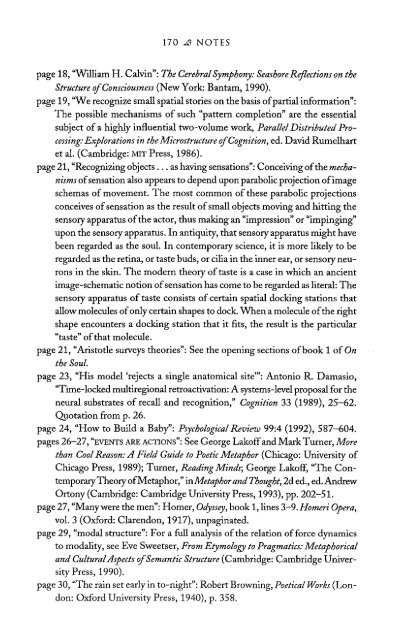The Literary Mind.pdf
The Literary Mind.pdf
The Literary Mind.pdf
Create successful ePaper yourself
Turn your PDF publications into a flip-book with our unique Google optimized e-Paper software.
170 NOTES<br />
page 18, "William H. Calvin": <strong>The</strong> Cerebral Symphony: Seashore Reflections on the<br />
Structure of Consciousness (New York: Bantam, 1990).<br />
page 19, "We recognize small spatial stories on the basis of partial information":<br />
<strong>The</strong> possible mechanisms of such "pattern completion" are the essential<br />
subject of a highly influential two-volume work, Parallel Distributed Processing:<br />
Explorations in the Microstructure of Cognition, ed. David Rumelhart<br />
et al. (Cambridge: MIT Press, 1986).<br />
page 21, "Recognizing objects... as having sensations": Conceiving of the mechanisms<br />
of sensation also appears to depend upon parabolic projection of image<br />
schemas of movement. <strong>The</strong> most common of these parabolic projections<br />
conceives of sensation as the result of small objects moving and hitting the<br />
sensory apparatus of the actor, thus making an "impression" or "impinging"<br />
upon the sensory apparatus. In antiquity, that sensory apparatus might have<br />
been regarded as the soul. In contemporary science, it is more likely to be<br />
regarded as the retina, or taste buds, or cilia in the inner ear, or sensory neurons<br />
in the skin. <strong>The</strong> modern theory of taste is a case in which an ancient<br />
image-schematic notion of sensation has come to be regarded as literal: <strong>The</strong><br />
sensory apparatus of taste consists of certain spatial docking stations that<br />
allow molecules of only certain shapes to dock. When a molecule of the right<br />
shape encounters a docking station that it fits, the result is the particular<br />
"taste" of that molecule.<br />
page 21, "Aristotle surveys theories": See the opening sections of book 1 of On<br />
the Soul.<br />
page 23, "His model 'rejects a single anatomical site'": Antonio R. Damasio,<br />
"Time-locked multiregional retroactivation: A systems-level proposal for the<br />
neural substrates of recall and recognition," Cognition 33 (1989), 25—62.<br />
Quotation from p. 26.<br />
page 24, "How to Build a Baby": Psychological Review 99:4 (1992), 587-604.<br />
pages 26-27, "EVENTS ARE ACTIONS": See George Lakoff and Mark Turner, More<br />
than Cool Reason: A Field Guide to Poetic Metaphor (Chicago: University of<br />
Chicago Press, 1989); Turner, Reading <strong>Mind</strong>s; George Lakoff, "<strong>The</strong> Contemporary<br />
<strong>The</strong>ory of Metaphor," in Metaphor and Thought, 2d ed., ed. Andrew<br />
Ortony (Cambridge: Cambridge University Press, 1993), pp. 202-51.<br />
page 27, "Many were the men": Homer, Odyssey, book 1, lines 3-9. Homeri Opera,<br />
vol. 3 (Oxford: Clarendon, 1917), unpaginated.<br />
page 29, "modal structure": For a full analysis of the relation of force dynamics<br />
to modality, see Eve Sweetser, From Etymology to Pragmatics: Metaphorical<br />
and Cultural Aspects of Semantic Structure (Cambridge: Cambridge University<br />
Press, 1990).<br />
page 30, "<strong>The</strong> rain set early in to-night": Robert Browning, Poetical Works (London:<br />
Oxford University Press, 1940), p. 358.















